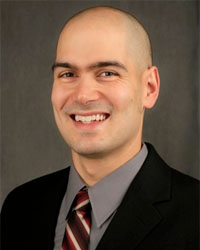
Ben Livneh, assistant professor at the University of Colorado at Boulder, will present "The Role of Climate on Hydrologic Extremes in the Northern Great Plains Region" at 2:30 p.m. Oct. 25 in the Hardin Hall Auditorium.
Abstract
The National Climate Assessment summarizes the impacts of climate change on the United States, now and in the future. This presentation will begin with an overview of the fourth National Climate Assessment (NCA4). Next, water-related science from Dr. Livneh's team will be presented focused on understanding the relationship between climate and extreme regional hydrologic events.
The research portion of this presentation will focus first on the recent 2012 drought event, which was accompanied by record deficits in precipitation and high temperatures during the May to August growing season. The primary objective is to understand the proximal causes of this drought event — whether driven by temperature versus precipitation — as well as important regional features of drought events more generally. Land Surface Model (LSM) simulations driven by daily observed meteorological forcing from 1950 to 2013 were first compared with satellite-derived terrestrial water anomalies, and the U.S. Drought Monitor. Growing-season droughts resulting principally from rainfall deficits were found to have a unique signature relative to droughts accompanied by high temperatures or low antecedent. Results from climate change scenarios are presented to comment on plausible Great Plains soil moisture changes in a warmer world.
Interestingly in the same broad region, observations reveal a sharp increase in the Upper Missouri River Basin's year-to-year streamflow variability. The variability of annual streamflow in the 20-year period 1993-2012 has doubled relative to the 20th century, with a disproportionate number of high streamflow years observed after 1993. Yet comparable changes in the variability of precipitation and temperature have not been observed. Of particular interest was the 2011 Missouri basin flood event that represented the largest flood records since observations began in 1898. Here, Livneh attempts to diagnose the causes of the streamflow changes, focusing on the relationship between land surface physics and the evolving characteristics of the meteorology. Outcomes of this research are expected to be broadly relevant in light of recent concerns over intensification of the hydrological cycle.
Speaker's Bio
Ben Livneh grew up in Ontario, Canada. He earned his first two civil engineering degrees at the University of Western Ontario. He earned his doctoral degree at the University of Washington under the guidance of Dennis P. Lettenmaier, where he worked on a wide range of problems related to large-scale computational hydrology. His dissertation focused on the development of the Unified Land Model (ULM) — a merger of two operational models: the Sacramento Soil Moisture Accounting Model and the Noah Land Surface Model. During his time in Seattle, Ben also taught several courses at Seattle University. He now leads a research group in the department of Civil, Environmental, and Architectural Engineering and he is also a Cooperative Institute for Research in Environmental Sciences (CIRES) fellow. Professor Livneh's research group addresses physical hydrology problems across multiple scales. Major research themes include physically-based hydrologic model development, land-cover/land-use change, snow hydrology, and hydroclimatology. The group is focused on applying models in innovative ways that integrate remote sensing and in situ observations to understand how changes in climate and land cover will affect water availability at the land surface. Professor Livneh frequently interacts with scientists at the Western Water Assessment, with the departments of Geography, INSTAAR, and ATOC.